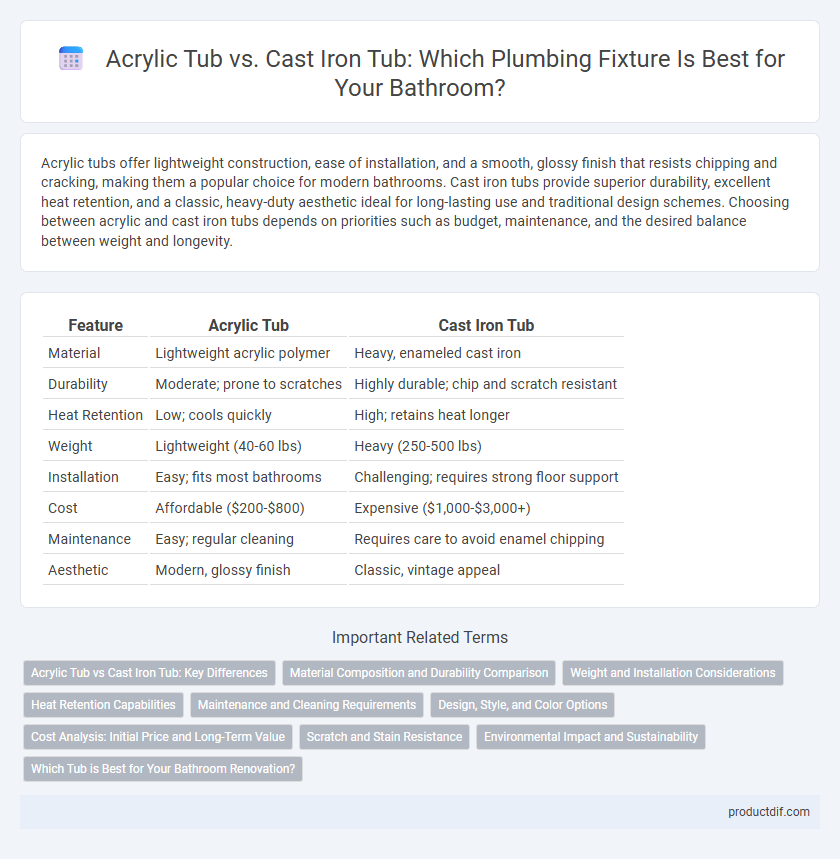Acrylic tubs offer lightweight construction, ease of installation, and a smooth, glossy finish that resists chipping and cracking, making them a popular choice for modern bathrooms. Cast iron tubs provide superior durability, excellent heat retention, and a classic, heavy-duty aesthetic ideal for long-lasting use and traditional design schemes. Choosing between acrylic and cast iron tubs depends on priorities such as budget, maintenance, and the desired balance between weight and longevity.
Table of Comparison
| Feature | Acrylic Tub | Cast Iron Tub |
|---|---|---|
| Material | Lightweight acrylic polymer | Heavy, enameled cast iron |
| Durability | Moderate; prone to scratches | Highly durable; chip and scratch resistant |
| Heat Retention | Low; cools quickly | High; retains heat longer |
| Weight | Lightweight (40-60 lbs) | Heavy (250-500 lbs) |
| Installation | Easy; fits most bathrooms | Challenging; requires strong floor support |
| Cost | Affordable ($200-$800) | Expensive ($1,000-$3,000+) |
| Maintenance | Easy; regular cleaning | Requires care to avoid enamel chipping |
| Aesthetic | Modern, glossy finish | Classic, vintage appeal |
Acrylic Tub vs Cast Iron Tub: Key Differences
Acrylic tubs are lightweight, heat-retentive, and resistant to chipping or cracking, offering easier installation and a modern appearance. Cast iron tubs provide exceptional durability, superior heat retention, and a classic, timeless look, but they are significantly heavier and require reinforced flooring. Choosing between acrylic and cast iron tubs depends on factors such as budget, installation feasibility, and desired aesthetic.
Material Composition and Durability Comparison
Acrylic tubs are made from a lightweight, flexible plastic composite that offers resistance to chipping and cracking but may be prone to scratching and fading over time. Cast iron tubs consist of a heavy, dense metal core coated with a layer of porcelain enamel, providing superior durability, heat retention, and resistance to wear. While acrylic tubs are easier to install due to their lighter weight, cast iron tubs generally offer longer-lasting performance and maintain their structural integrity under heavy use.
Weight and Installation Considerations
Acrylic tubs typically weigh between 70 to 100 pounds, making them significantly lighter and easier to install compared to cast iron tubs, which can weigh from 250 to 500 pounds. The reduced weight of acrylic tubs allows for simpler handling and less structural support during installation, ideal for upper floors or renovations with weight restrictions. Cast iron tubs require reinforced flooring and professional installation due to their heavy mass and rigidity, increasing labor and material costs.
Heat Retention Capabilities
Acrylic tubs have moderate heat retention, typically cooling faster due to their thinner walls and lower density. Cast iron tubs excel in heat retention, maintaining warm water temperatures much longer thanks to their thick enamel-coated iron construction. This superior heat retention in cast iron enhances bathing comfort by providing a consistently warm soak.
Maintenance and Cleaning Requirements
Acrylic tubs require less maintenance due to their non-porous surface that resists stains and mildew, making cleaning with mild, non-abrasive products simple and effective. Cast iron tubs demand more rigorous upkeep to prevent rust and enamel chipping, often needing gentle scrubbing and periodic refinishing to maintain their glossy surface. Regular sealing of cast iron tubs enhances durability, whereas acrylic tubs benefit from quick wipe-downs to prevent soap scum buildup.
Design, Style, and Color Options
Acrylic tubs offer versatile design options with sleek, modern shapes and an extensive range of color choices that easily complement contemporary bathroom styles. Cast iron tubs, known for their classic and timeless appeal, typically come in fewer color options but provide a substantial, glossy enamel finish that enhances traditional and vintage-inspired bathroom designs. The lightweight nature of acrylic allows for more creative freedom in style, while cast iron tubs are prized for their durability and elegant presence in luxury bathroom settings.
Cost Analysis: Initial Price and Long-Term Value
Acrylic tubs typically have a lower initial price, ranging from $300 to $1,000, offering affordability for budget-conscious buyers. Cast iron tubs cost significantly more upfront, with prices between $1,200 and $3,000, but they provide superior durability and longevity, often exceeding 50 years of use. Considering long-term value, cast iron tubs require less frequent replacement or repair, making them a cost-effective investment despite higher initial expenses.
Scratch and Stain Resistance
Acrylic tubs offer moderate scratch resistance but can be more prone to staining compared to cast iron tubs, which are highly resistant to both scratches and stains due to their durable enamel coating. The non-porous surface of cast iron tubs prevents discoloration, making them a superior choice for maintaining a clean, polished appearance over time. Homeowners seeking long-lasting durability with minimal maintenance often prefer cast iron tubs for their scratch and stain resistance properties.
Environmental Impact and Sustainability
Acrylic tubs have a lower environmental impact due to their lightweight nature, which reduces transportation emissions and energy consumption during manufacturing. Cast iron tubs, while more durable and long-lasting, require more energy-intensive production and mining processes for raw materials, increasing their carbon footprint. Recycling options for cast iron tubs enhance sustainability, whereas acrylic tubs pose challenges in recyclability and potential microplastic pollution.
Which Tub is Best for Your Bathroom Renovation?
Acrylic tubs offer lightweight design, easy installation, and resistance to chipping, making them ideal for budget-friendly bathroom renovations, while cast iron tubs provide exceptional durability, heat retention, and classic aesthetics, suitable for long-term investment. Choosing between acrylic and cast iron depends on factors like bathroom size, installation complexity, and desired style, with acrylic tubs being more versatile for contemporary spaces and cast iron tubs favored for traditional designs. Considering maintenance, acrylic requires less effort but may scratch more easily, whereas cast iron demands professional handling but resists wear over decades.
acrylic tub vs cast iron tub Infographic

 productdif.com
productdif.com